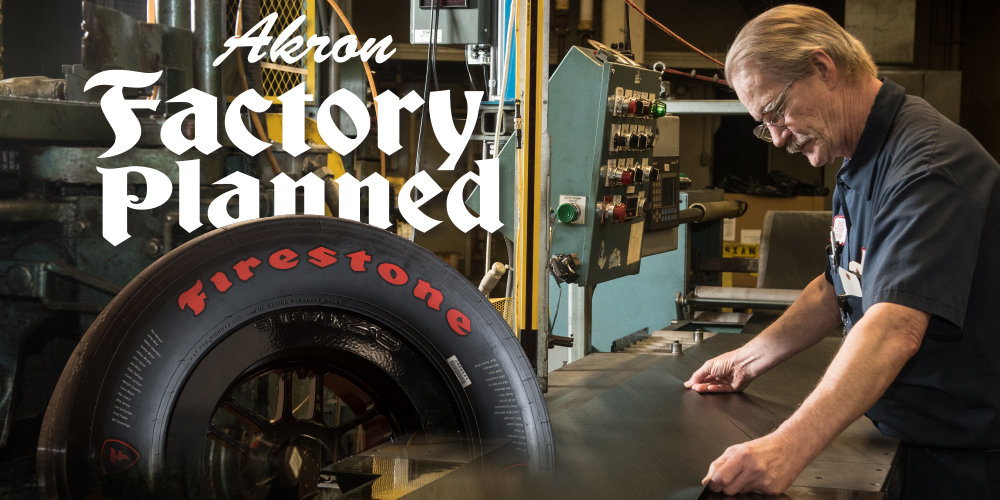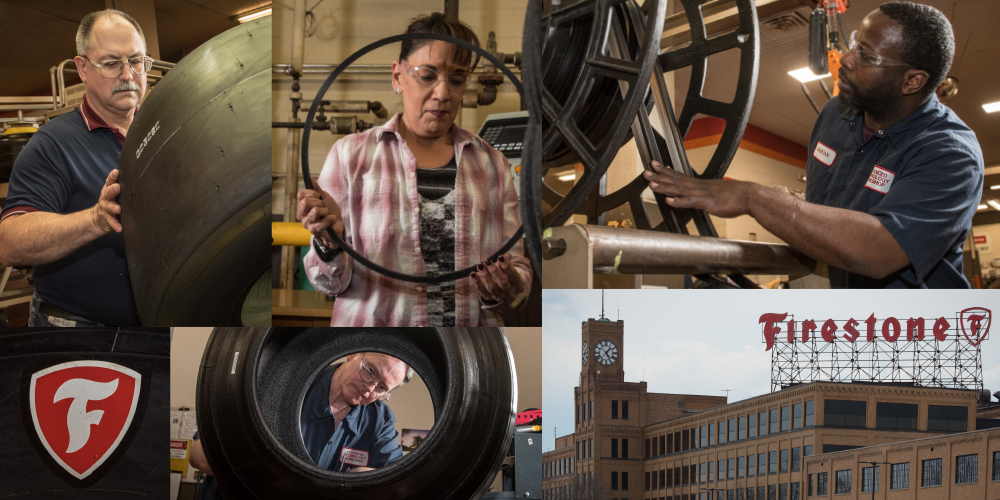Construction starts this summer on a new state-of-the-art factory for Firestone race car tires in Akron, Ohio, an investment that skilled USW-represented tire builders hope will solidify their future.
“It’s really great news. We’re happy that the long tradition of producing Firestone race tires stays here in Akron,” Local 7 President Jack Rocco said after Bridgestone Americas announced that it would build the factory, named the Advanced Tire Production Center (ATPC), to produce Firestone’s Firehawk race tires.

“It’s a win-win situation and you don’t hear about those too often. Our hard-working members get job security. The company gets an experienced work force and showcases their cutting-edge technology at the race track,” Rocco added.
Contract extended
On Feb. 6, Bridgestone-owned Firestone extended its exclusive contract to build race tires for the NTT IndyCar Series through the 2025 racing season. The new factory in Akron was announced on the same day to support the extension.
Firestone is the sole tire supplier to the IndyCar series and its premier event, the Indianapolis 500. This year, more than 26,000 Firehawk race tires built in Akron by Local 7 will be leased to IndyCar race teams.
More than 6,000 tires will be used in track activities related to the 103rd Indianapolis 500 on May 26. Sleek, low-profile, open-wheel Indy cars with driver exposed cockpits will cover 200 laps around a 2.5-mile oval track.
Firestone’s tire builders are aware their products are used at speeds approaching 240 miles per hour and pay keen attention to every detail.
“We make the best race tires in the world here,” Local 7 member John Larkins said as he carefully inspected a finished product. “We can’t afford to have something go wrong. This is our livelihood.”
Harvey Firestone, who began his namesake company in Akron in 1900, was a pioneer in using auto racing to promote his brand. The inaugural run in 1911 of the Indianapolis 500 was won on Firestone tires by driver Ray Harroun, who averaged 74.6 miles per hour.
Production center
Still under design, the new ATPC will be located down the street from where Firestone race tires have been produced since the brand returned to the IndyCar Series in the mid-90’s. Plans for the ATPC include new construction and the full renovation of an existing structure.
“Everybody involved made good decisions, from the company to the workers, to the political leadership here in Akron. We were all pretty much on the same page, trying to keep jobs here,” Rocco said.
“Our retirees really set the table for us to succeed. Now we have to take the baton and make good decisions going forward. We also look forward to passing our knowledge onto a younger crew recently hired.”
Once the rubber capital of the world, Akron was home to the former United Rubber Workers (URW) union, and corporate headquarters of several major tire companies including Firestone, General Tire, Goodrich and Goodyear. Only Goodyear maintains a headquarters in Akron today.
Japan’s Bridgestone Corp. merged with Firestone in 1988. Its U.S. subsidiary, Bridgestone Americas, is based in Nashville, Tenn. Both Firestone and Goodyear do research and development in Akron and make race tires there.
The last full-scale tire factory in Akron, General Tire’s Plant 1, shut down in 1982. Goodrich stopped making passenger tires in Akron in 1975; Goodyear in 1978. Firestone ended passenger tire production in Akron in 1981.
Local 7, once 7,000 members strong, traces its roots to 1935 when the URW was formed with the goal of improving wages and working conditions for a growing industry. The URW merged with the USW in 1995.
Move in four years
Today the local represents 68 USW members, including 50 who manufacture race tires in two shifts at the current production facility. They will move to the new location over four years. The remaining members staff a warehouse and work in maintenance at other Firestone buildings.

Larkins, 59, said there had been talk about closing the old factory since he was hired on 21 years ago. It’s a relief for him to see Firestone starting to build a new facility and investing in machinery.
“Plus you want a job that has union protection,” he said. “We have good benefits, good pay and a good place to work. If it wasn’t for the union, we wouldn’t have all those things.”
Irma Finnerty, an experimental technician who tests and produces parts, said the new factory is “absolutely good news” for a work force that had been unsure of its future.
“It lets us know we’re doing a good job,” said Finnerty, a 21-year veteran interviewed as she was sampling wire. “It sets us up for retirement.”
Motorsports are a key part of research and development in the highly competitive tire industry. Even though rubber tires have been built for more than a century, technology continues to evolve. What is learned in building race tires eventually ends up on passenger cars and vans and commercial trucks.
“For 100 years racing has been a proving ground for our tire technologies,” said Dan Peterman, manager of race tire production and building services for Bridgestone Americas in Akron. “We use the race tire to drive innovations. Every (consumer) tire has some in it. They share more than people realize.”
Best way to go
In planning the new project, Peterman said the decision was made to keep race tire production close to corporate research and development at the Bridgestone Americas Technical Center in Akron. “We quickly realized that keeping everything here was the best way to go,” he said.
The tire building process starts with mixing natural rubber with various compounds and chemicals in a large machine called a Banbury, which grinds and heats the rubber to make it workable.
Several other machines are used to extrude parts and make tire components such as belts, beads and sidewalls. Tread is made for Firestone rain tires although most of the tires built in Akron are racing slicks.
The components come together on a tire machine, which was off limits to a USW@Work photographer for competitive reasons. A skilled tire builder assembles an uncured or green tire, which is placed in a mold and hardened or vulcanized.
Firestone supplies 60 different tires to IndyCar, each designed to cope with different weather and track conditions on the circuit. Softer compounds yield a better grip and harder compounds run longer.
Harold Hutchens II, a third-generation Firestone employee, compares the process of building a race car tire to buying a custom-made suit. Race tires are tailor made for individual races and tracks in a process that requires more hands-on work than mass produced passenger ties.
Race tire engineers are concerned about issues like reducing rolling resistance, increasing road grip and improving durability. On certain tracks, like the Indy 500, a different tire is designed for each of the four wheels. “Each side takes a different load at that 240-mile-per-hour speed,” Peterman said.
With so much technology in each race tire, it’s no surprise that the major manufacturers carefully track and guard them. The tires are leased to race teams and collected after racing. The used tires are analyzed for wear and then responsibly converted into fuel for energy.
“Every tire is tracked from cradle to grave,” Peterman said.
